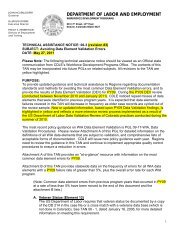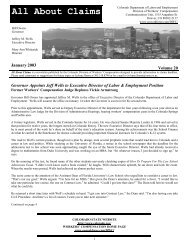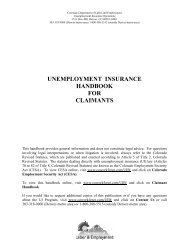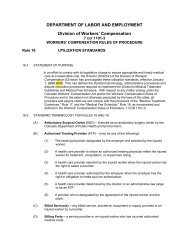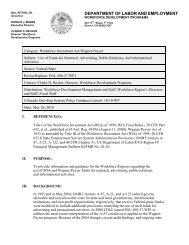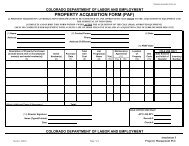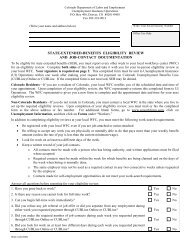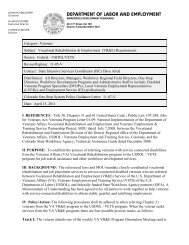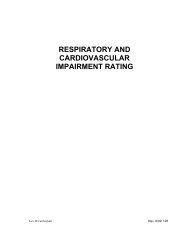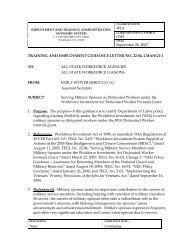Impairment Rating Tips - Colorado Department of Labor and ...
Impairment Rating Tips - Colorado Department of Labor and ...
Impairment Rating Tips - Colorado Department of Labor and ...
Create successful ePaper yourself
Turn your PDF publications into a flip-book with our unique Google optimized e-Paper software.
Complex Regional Pain Syndrome (CRPS)-formerly known as Reflex Sympathetic Dystrophy: The Division<br />
recommends using the spinal cord table (Table 1, pg. 109, AMA Guides) for determining impairment, however<br />
the peripheral nerve tables may be used if the evaluator deems them more appropriate (Table 14, pg. 46; Table<br />
51, pg. 77, Table 10 pg. 42, AMA Guides). In unusual cases where severe vascular symptoms cause additional<br />
impairment <strong>of</strong> ADL’s the physician may choose to combine additional impairment for the vascular tables with<br />
the neurological impairment. (Table 52, pg. 79 <strong>and</strong> Table 16, pg. 47, AMA Guides). Range <strong>of</strong> motion should<br />
not be used, as this would be accounted for in the neurologic portion <strong>of</strong> the rating.<br />
Additional Notes for Physicians on the IME Panel:<br />
IME Application: When completing the narrative <strong>and</strong> worksheets for the IME, make sure you address all <strong>of</strong><br />
the issues <strong>and</strong>/or all <strong>of</strong> the body parts listed on the IME application. Some <strong>of</strong> them are very specific.<br />
Performing <strong>Rating</strong>s: Just because you are asked to address a body part or condition that is listed on an IME<br />
application does not mean you have to rate that condition if you do not feel it is work-related or qualifies for<br />
permanent impairment. You should, however, acknowledge it in some fashion to ensure that all listed issues are<br />
addressed. Remember that you do not have to provide worksheets if you are not giving a rating for the injury(s)<br />
in question.<br />
MMI Status: Be specific about MMI status <strong>and</strong> date <strong>of</strong> MMI. If you agree with an authorized treating<br />
physician regarding MMI status <strong>and</strong> date, state the name <strong>of</strong> that doctor as well as the MMI date. Some changes<br />
have been made to the IME summary sheet to reflect this need for more specific information.<br />
<strong>Impairment</strong> when “Not at MMI”: Remember that an IME is a legal/medical proceeding <strong>and</strong> you are being<br />
asked to provide specific information. If the party requesting the IME has asked that impairment be addressed,<br />
<strong>and</strong> if you find the patient not at MMI for that work-related injury, you should nevertheless provide a rating for<br />
that injury. This information can be used by the parties for negotiations, settlement, or to help assess further<br />
treatment needs.<br />
Recommendations for Additional Treatment: Division Independent Medical Examiners frequently<br />
recommend further treatment. To avoid ambiguity <strong>and</strong> controversy, we recommend that independent medical<br />
examiners consider the following legal opinion issued by the Industrial Claim Appeals Office, Gebert v.<br />
Nordstrom, Inc., W.C. No. 4-428-645 (ICAO, June 20, 2003), “A recommendation for therapies which present a<br />
reasonable prospect for improving physical function may be viewed as evidence that the claimant’s condition is<br />
not stable, <strong>and</strong> the resulting impairment is not measurable. Therefore such treatment recommendations are<br />
inconsistent with MMI…. Of course it is also true that treatment which is provided merely to maintain the<br />
claimant’s condition by preventing deterioration, or to relieve continuing symptoms, is not inconsistent with<br />
MMI <strong>and</strong> may be awarded thereafter.”<br />
The Division Independent Medical Examiner must clearly indicate whether the treatment recommendations in<br />
the IME report are intended as maintenance treatment or if the treatment could affect the MMI date given the<br />
above statement. If the examiner indicates that the treatment recommended would affect the MMI date, the<br />
examiner should also indicate whether the patient would be at maximum medical improvement as <strong>of</strong> a specific<br />
date in the event the patient refused to undertake the treatment suggested by the examiner. That “specific date”<br />
may or may not be the date <strong>of</strong> your exam. Remember that the statute defines MMI as: “A point in time when<br />
any medically determinable physical or mental impairment . . . has become stable <strong>and</strong> when no further<br />
treatment is reasonably expected to improve the condition. The requirement for future medical maintenance<br />
which will not significantly improve the condition or the possibility <strong>of</strong> improvement or deterioration resulting<br />
from the passage <strong>of</strong> time shall not affect a finding <strong>of</strong> [MMI].”<br />
DK 11 Rev. 6/05 4



